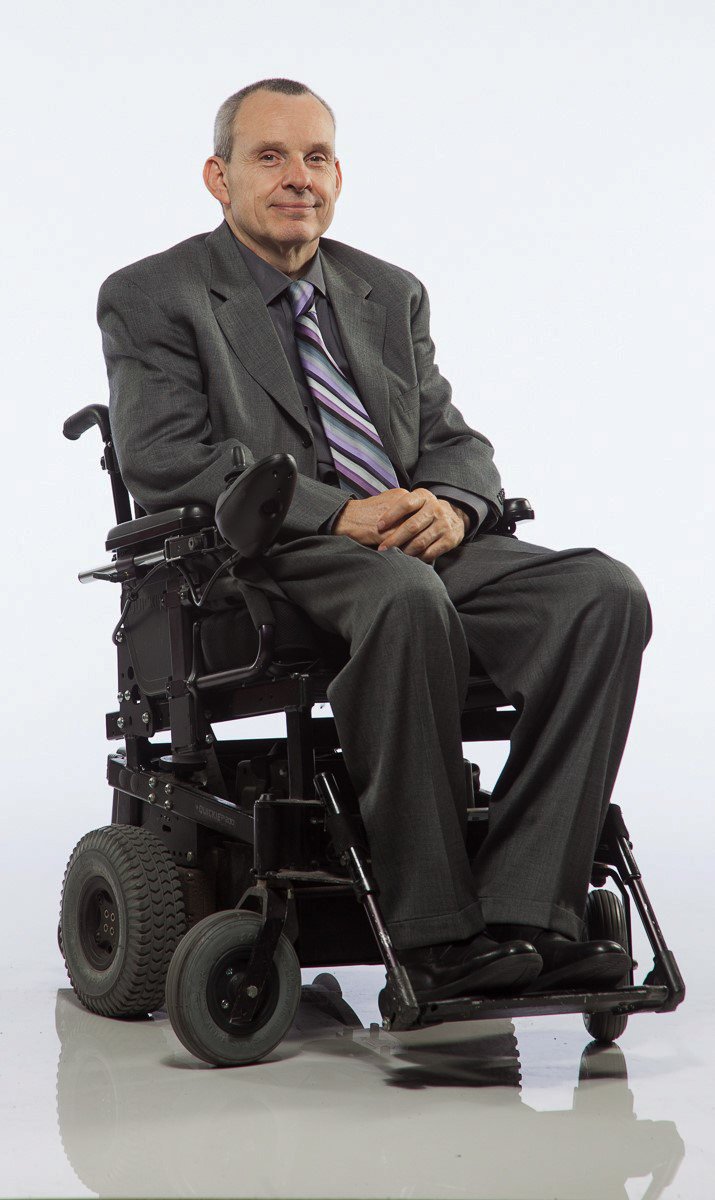An X-ray revealed that LeBrecht had a rotator cuff muscle tear in his shoulder, a common injury for manual wheelchair users. “I was thinking that the longer I use my shoulders and arms as much as possible, the better shape I’ll be in,” says LeBrecht. But he did lasting damage each time he hurt his shoulder, even though he thought he had recovered. He was unwilling to undergo surgery, given the months of absolute dependency and danger of pressure sores it would entail. “The risks of the recovery process and the percentage chance of it really taking were just not good enough,” he says.
The only answer remaining was a move to power. LeBrecht came to appreciate the benefits of a power chair over a manual one, especially since he lives in a hilly neighborhood in Berkeley, California. “I just couldn’t go out in my neighborhood in a manual chair,” he says.
Energy Preservation
The switch to power is not always about accommodating an injury. For Phil Pangrazio, CEO of Ability 360 in Phoenix, Arizona, it had everything to do with preserving his energy. Injured in 1979 at C6-7, Pangrazio used a manual chair until 2005, when the pace of his work made it hard to get through a busy day without being seriously fatigued. “I knew if I was going to keep doing what I was doing that I needed my energy,” he says. He admits that not using a power chair was a matter of pride. “If you’re in that ‘super quad’ category like me, where you’ve got enough physical ability to push a manual wheelchair, you’re going to do it.”
Using a power chair instead was also a matter of comfort. “It is just easier to sit in a power chair all day long than in a manual,” he says. Manuals are primarily designed for mobility, as upright posture and firm contact with the back of the chair is key to being able to make the most of your available strength and balance. A tradeoff of efficiency over comfort has to be made with a manual chair.
The power chair can have a more reclined back, which supports your upper body weight, making you more comfortable. And given that an adjustable reclining feature is common to many models, you get more control over what feels best over the course of a day. You feel more stable and secure.
The Price of Power
There’s a learning curve when you switch to power. The added weight and extra speed of a power chair have to be considered in ways that are not the case with a manual.
“My banged up walls and cabinets could tell the story,” says Kunze. And LeBrecht actually broke an elderly woman’s toe when she stepped into his path of travel — but he grants that he could have been going slower.
LeBrecht learned about a Permobil C300 with tilt and elevation available from a family who had lost a member to ALS. He paid just $1,500 for it. But most people are likely to get caught in a very long process of selecting a chair, waiting for delivery and then paying out of pocket for a good share of it.
He got lucky, as the cost of a power chair can be steep, commonly in the tens of thousands, and often wheelchair users have to fight with insurers. To increase your chance of winning those battles, try to find a seating professional and provider willing to advocate for you. And, of course, you need to be sure that the provider you work with is in your funder’s network.
It’s an unfortunate fact that a lot of wheelchair options don’t have insurance codes, which means they have to be paid for out of pocket. As you work through the options on the order forms, be sure you know exactly what a feature will cost you. If it’s important enough to you, you may have to pay for it yourself. Things like specialized chair backs, for instance, with ergonomic adjustment, lumbar support and so on, might be something you will have to choose to fight for, pay for, or just pass on.
So there are upsides and downsides to power. The perks include greater mobility, more comfort and even more flexibility in parking. “It doesn’t matter if I have to park three blocks away downtown for a meeting. Boom. I’m over there with the power chair,” says Pangrazio.
But using power means if you don’t already have an adapted van, you’ll probably have to get one. Van conversions are expensive and hard to get funded outside of Voc Rehab, but you may be able to find a deal on a used lift-equipped van (see Tips for Buying a Used Wheelchair Van, November 2018).
Lastly, keeping that manual chair around is a common strategy. You might still be able get around the house in it, and if your power chair breaks down, you’ll have a handy back-up.
** This post was originally published on https://www.newmobility.com/2020/10/embracing-power/


